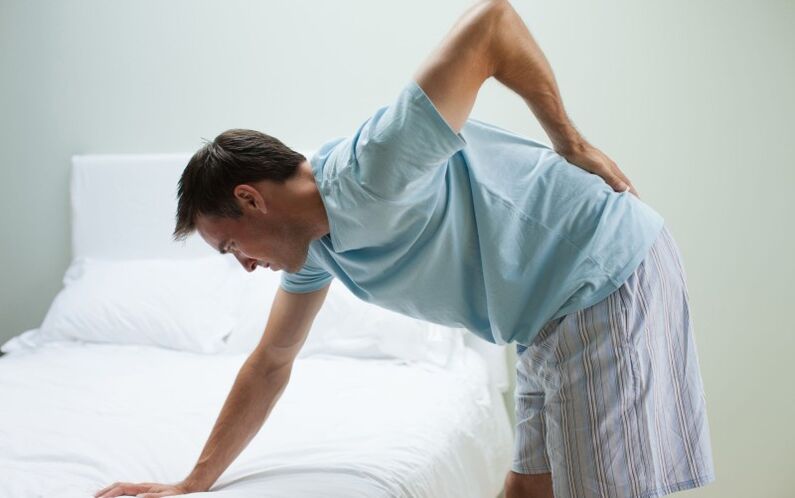In clinical practice, back pain is a fairly common syndrome. When the patient feels "girdle" pain, it affects the lower back. Degenerative, musculoskeletal and dystrophic pathologies manifest themselves in the form of osteochondrosis or spondyloarthritis.
Back pain - causes and symptoms
In medicine, the following causes of back pain are traditionally distinguished:
- Infectious and inflammatory processes in the spine;
- Muscle cramps or compressed nerves;
- Formation of intervertebral hernia;
- Spinal cord or spinal metastases;
- Scoliosis, lordosis, kyphosis;
- Circulatory disorders (stroke, paralysis);
- pathology of the gastrointestinal tract (atypical manifestations of inflammation of the appendicitis, obstruction of the bile ducts and intestines);
- Diseases of the kidneys, reproductive organs;
- In some cases, women may experience discomfort in the lower back during late pregnancy.
Back pain can be acute or persistent (chronic). They can also be "wanderers", that is. arises in another organ, but give the lower back.

Acute pain is sudden, piercing, can impede movement, and can affect the lower extremities and hips. The patient has a forced body position and limited mobility.
Acute pain is diagnosed in the following cases:
- stretch the long muscles of the back;
- spinal fractures and protrusion of intervertebral discs;
- facet syndrome (compression of the nerve root, without displacement of the vertebral discs);
- epidural abscess (the patient needs to be hospitalized immediately because of the high risk of spinal cord compression);
- dystrophic anomalies of the hip joint.
Chronic low back pain is characterized by loss of sensation, "lumbago" in the gluteus muscle, weakness of the lower extremities, the formation of bone protrusions.
The patient may experience postural disorders, interstitial claudication, deformity of the legs.
Chronic low back pain occurs in the following cases:
- osteochondrosis;
- ankylosing spondylitis;
- metastatic and intradural tumors.
Diagnosis and treatment of low back pain
The true cause of back pain can be determined by CT (computed tomography), MRI (magnetic resonance imaging), X-ray or ultrasound examination of internal organs. The first two methods provide a comprehensive assessment of the condition of bone and soft tissues, radiography shows the integrity of the bones and the presence of neoplasms, and ultrasound shows diseases of the organs and their systems.
The therapeutic course is prescribed only by the attending physician, depending on the diagnosis, it may include: analgesics, hormonal medications, physiotherapy procedures or a course of manual therapy, exercise therapy. If the pain is caused by disc displacement or develops against the background of osteochondrosis, wearing a tight fixation corset is effective. It significantly relaxes the lumbosacral region, prevents muscle overload and spasms. A good therapeutic effect is given by blockades - special injections into the intervertebral joints. They relieve pain and relax muscles.
In severe cases, surgery may be required. It is very important to seek qualified medical care in a timely manner, not to treat yourself.
During the rehabilitation period, you should regularly do physiotherapy exercises, massage and physiotherapy. This will help relieve muscle tension, improve blood flow and reduce congestion.
General recommendations for sacro-lumbar pain:
- follow bed rest. In this case, the bed should have a hard, flat surface. Strictly exclude soft, low mattresses.
- Put on a supportive bandage. It is especially important for pregnant women in the third trimester.
- painkillers are allowed.
- Rub your back with ointments with warming and anti-inflammatory components. Under no circumstances should you overcool it, it is better to wear a woolen scarf or a warm belt when the pain worsens.
Back pain during pregnancy
If we talk about back pain during pregnancy, then they are associated with changes in the center of gravity of the female body in connection with the development and growth of the fetus. Also, as a result of hormonal changes (excessive production of relaxation), the hip-sacral joints relax, which upsets the balance. Excessive bending of the abdomen and spine increases the pressure on the lumbar region. Muscles are constantly overloaded, which is the main cause of pain.
The risk group includes girls with problems with the development of hip muscles before pregnancy, impaired posture, osteochondrosis and neurological disorders of the spine. Painful sensations do not appear until the second trimester, and this is about the fifth or sixth month. It can be relieved by strengthening the muscles with a special set of exercises. And the sooner you start training your back muscles, the easier it will be to endure a healthy child.



































